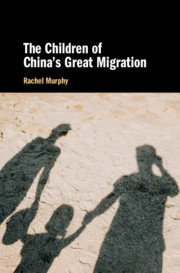Book contents
- The Children of China’s Great Migration
- The Children of China’s Great Migration
- Copyright page
- Contents
- Figures and Maps
- Tables
- Acknowledgements
- 1 Understanding the Lives of Left-Behind Children in Rural China
- 2 Migration, Education and Family Striving in Four Counties of Anhui and Jiangxi
- 3 Sacrifice and Study
- 4 Boys’ and Girls’ Experiences of Distribution in Striving Families
- 5 Children in ‘Mother At-Home, Father Out’ Families
- 6 Children of Lone-Migrant Mothers and At-Home Fathers
- 7 Children in Skipped Generation Families
- 8 Left-Behind Children in Striving Teams
- Appendix: Field Research on Left-Behind Children in China
- Bibliography
- Index
5 - Children in ‘Mother At-Home, Father Out’ Families
Published online by Cambridge University Press: 06 August 2020
- The Children of China’s Great Migration
- The Children of China’s Great Migration
- Copyright page
- Contents
- Figures and Maps
- Tables
- Acknowledgements
- 1 Understanding the Lives of Left-Behind Children in Rural China
- 2 Migration, Education and Family Striving in Four Counties of Anhui and Jiangxi
- 3 Sacrifice and Study
- 4 Boys’ and Girls’ Experiences of Distribution in Striving Families
- 5 Children in ‘Mother At-Home, Father Out’ Families
- 6 Children of Lone-Migrant Mothers and At-Home Fathers
- 7 Children in Skipped Generation Families
- 8 Left-Behind Children in Striving Teams
- Appendix: Field Research on Left-Behind Children in China
- Bibliography
- Index
Summary
In the 2010s rising aspirations for children’s education reinforced gendered ideas about the best way for rural families to configure themselves. In villages with few off-farm earning opportunities, people saw ‘mother home and father out’ to be optimal for investing in the next generation. But actually-existing versions of this family configuration were stratified. Specifically, families where a father worked overseas or where a migrant mother had returned to peidu (accompany studies) in the county seat gave children greater investments of parental money and time. At the other end of the spectrum, though, were children whose mothers had to stay at home - because of the lack of alternative childcare and their own unsuitability for urban labour markets - while their fathers remitted little. Although people thought that a mother’s at-home care would ensure that the migrant father’s toil was not in vain, the mothers did not tutor the children. Instead, the children benefited from their mothers’ provision of comfort and routine, which helped them to concentrate on their studies. Meanwhile, children saw fathers who provided for them materially as committed to them. But fathers still needed to interact warmly with their children for there to be intimacy in the relationship.
- Type
- Chapter
- Information
- The Children of China's Great Migration , pp. 132 - 161Publisher: Cambridge University PressPrint publication year: 2020



